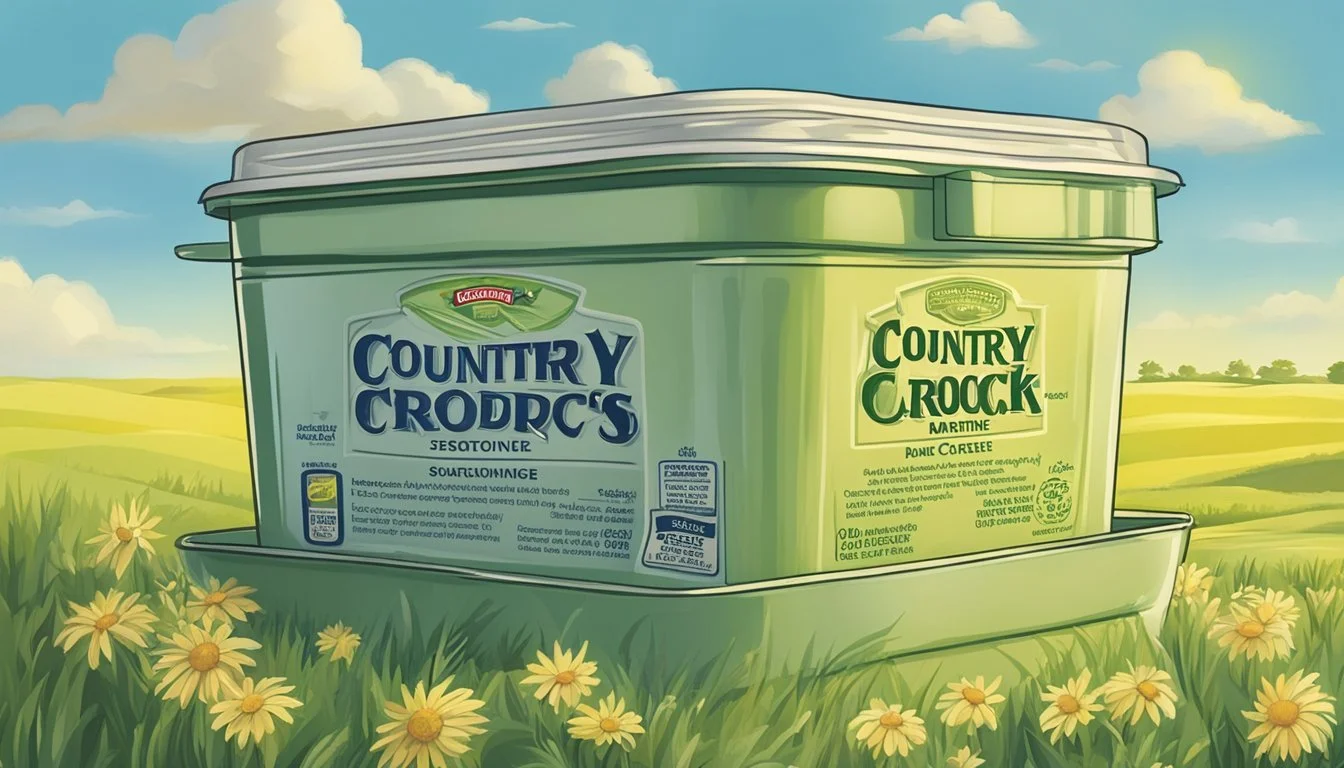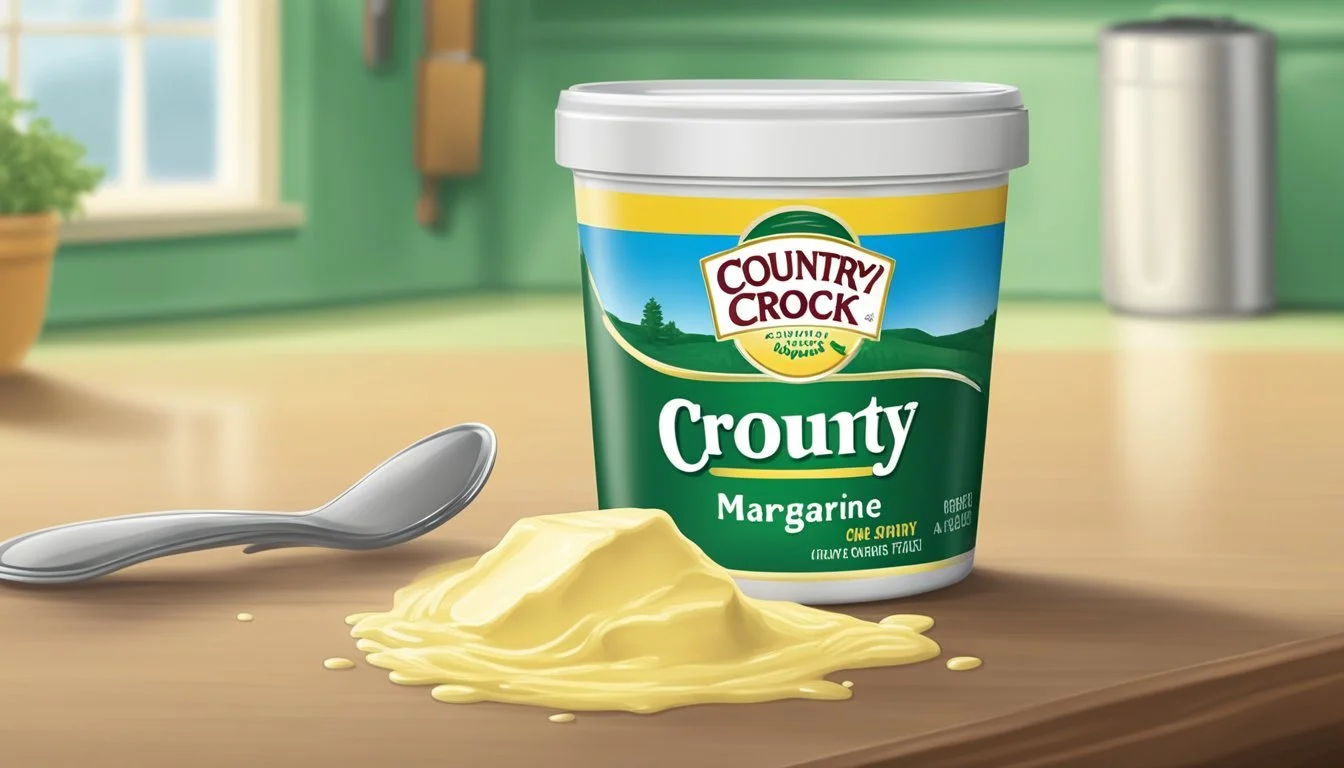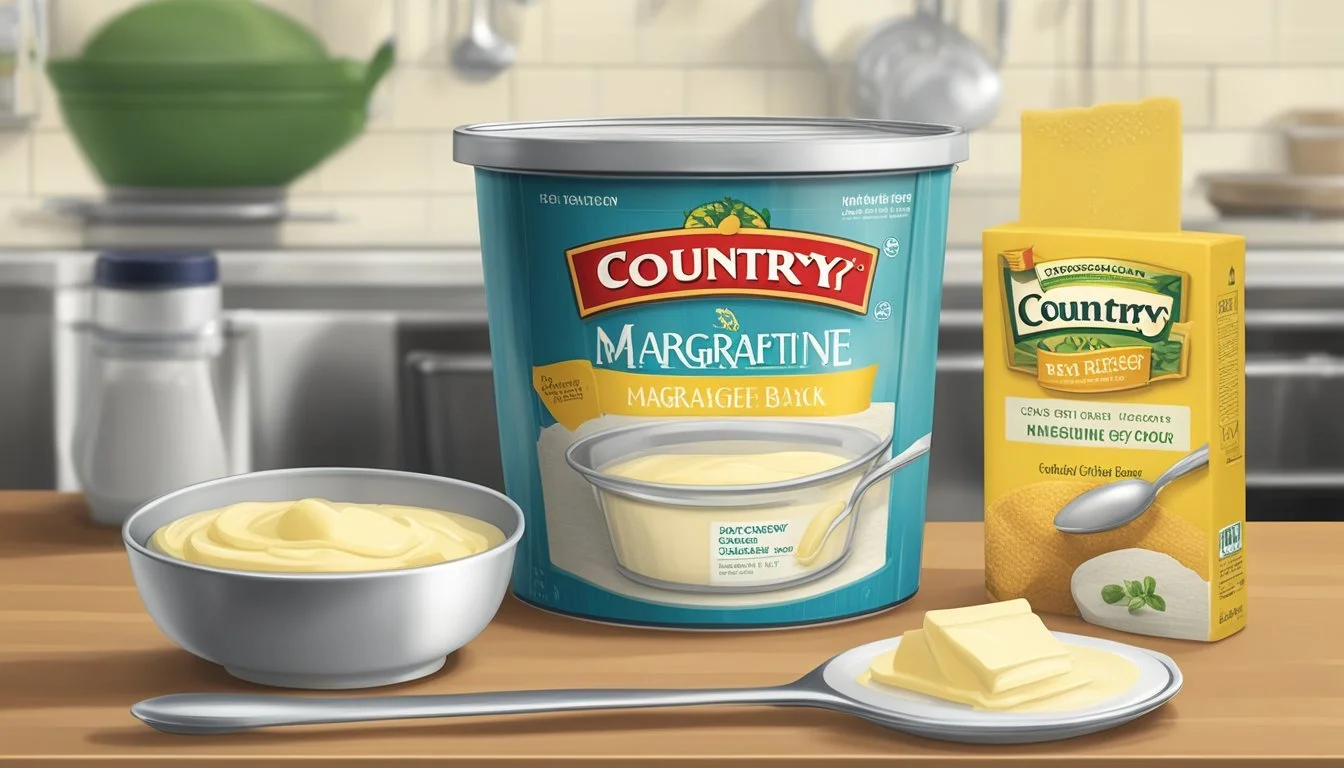How Long Does Country Crock Margarine Last?
Shelf Life Explained
Country Crock is a popular brand of margarine, a spread commonly used as a substitute for butter (how long does butter last?). Margarine, like butter, is susceptible to spoilage and must be stored properly to extend its shelf life. Country Crock margarine's longevity after production is typically around 180 days when stored in the right conditions. Refrigeration is crucial for preserving the freshness of the margarine and preventing the spread from going bad.
Proper storage methods directly impact the shelf life of margarine. Country Crock and other margarine products should always be refrigerated after opening and sealed tightly to prevent exposure to air and contaminants. A clean utensil should be used with each use to avoid introducing bacteria into the product. These measures will help maintain the quality of the margarine and prevent premature spoilage.
When left at room temperature, margarine can last for a significantly shorter period. While it may be safe to leave margarine out for short stints, such as during a meal, extending this time risks the product becoming rancid and developing off flavors. In any case, consistent refrigeration is recommended to ensure the margarine remains safe to consume and retains its optimal flavor profile for an extended period.
Understanding Margarine
Margarine is a staple in many households as a versatile spread and a key ingredient in various recipes. This section explores its composition, health implications, and the distinct features of Country Crock, a prominent brand in the market.
Composition and Types
Margarine is primarily made from vegetable oils, and its consistency ranges from hard to soft, depending on the degree of hydrogenation of the oils used. These vegetable oils are transformed into solid form through a process that may involve the creation of trans fats, which are known to be unhealthy in high amounts. However, most margarines today are made to be trans fat-free. There are several types of margarine available, and they may contain different ingredients, including:
Emulsifiers
Colorants
Preservatives
Salt
Additional flavors and vitamins (like Vitamin A and D)
Health Considerations
Margarine was traditionally seen as a healthier alternative to dairy butter due to its lower levels of saturated fats, but not all margarine is created equal. Some margarines may contain trans fats that have been linked to increased cholesterol levels. When choosing margarine, it's recommended to check the label for ingredients and fat content. Modern margarines tend to prioritize health, offering:
Low or no trans fats
Lower saturated fats than butter
Often fewer calories per serving compared to butter
Country Crock as a Brand
Country Crock is well-known for producing margarine and plant butter products. Their products are known for being made from plant-based oils, which include ingredients such as palm fruit oil and soybean oil. The brand focuses on the spreadability and taste of its products, ensuring they work well both for cooking and as a spread. Country Crock products are advertised as having:
Less saturated fat than dairy butter
A buttery taste despite being dairy-free
Varieties that are softer and easier to use straight from the refrigerator
Shelf Life Fundamentals
The shelf life of Country Crock margarine primarily hinges on how it's stored and when it's opened. Readers are expected to understand that the freshness and quality of margarine diminish over time, and knowing when the product crosses its prime is essential for both taste and health.
Factors Affecting Shelf Life
Several factors contribute to the longevity of Country Crock margarine:
Temperature: Storage at room temperature reduces shelf life, while refrigeration and freezing extend it.
Exposure to Light and Air: Margarine deteriorates quicker when exposed to light and air.
Seal Integrity: The tightness of the seal post-opening can affect the rate of spoilage.
Usage Habits: Using a clean utensil each time helps prevent the introduction of contaminants.
Expected Duration
The expected shelf life of Country Crock margarine can be broken down as follows:
Unopened: Typically stays fresh up to the expiration date listed on the packaging.
Opened: When refrigerated, it is expected to maintain best quality for 1-2 months; however, it can last up to 180 days under ideal conditions.
State Fridge Freezer Unopened Up to expiration date Often safe beyond expiration date Opened 1-2 months 6-8 months
Signs of Margarine Spoilage
One should discard their margarine if they observe:
Odor: A rancid or off-smelling aroma is a key indicator of spoilage.
Texture: Any signs of separation or hardening suggest degradation.
Taste: A noticeable difference from the original buttery flavor.
Detecting these signs ensures that only Country Crock margarine of the best quality and freshness is consumed, preventing potential food-borne illness.
Proper Storage Techniques
To maintain quality and extend the shelf life of Country Crock margarine, proper storage techniques are essential. Adhering to the recommended temperatures and storage conditions keeps the spread at its best.
Room Temperature vs Refrigeration
Refrigeration is the recommended way to store Country Crock margarine for optimal shelf life and freshness. It should ideally be kept at a temperature range of 32-41°F (0-5°C). While margarine can remain at room temperature for brief periods, generally 2-3 days, it is susceptible to spoilage and should be refrigerated properly to prevent the growth of mold and bacteria.
Freezing Margarine
Country Crock margarine can also be stored in the freezer where it can last for 6-8 months. To freeze, one should ensure that the packaging is airtight and not conducive to freezer burn. The texture and flavor may change slightly upon thawing, so freezing is best done when longer storage is needed.
Container and Packaging
The margarine should always be kept in its original container with the lid tightly closed to maintain freshness and deter absorption of other food odors. When refrigerating, it is crucial to store the margarine away from direct light and in a part of the fridge that maintains a consistent temperature, away from the door where temperature fluctuations are most frequent. If the packaging is damaged, transferring the margarine to an airtight container is advised.
Identifying Spoiled Margarine
It's important for consumers to recognize the signs of spoiled margarine to ensure food safety. Margarine spoils due to factors like overexposure to heat, light, or being kept past its expiration date.
Changes in Odor and Flavor
Spoiled margarine often develops an off, rancid smell, which may resemble paint or be distinctly sour. The taste may be unpleasantly soapy or have a paint-like quality. If one detects changes in the general flavor profile of the margarine, it should be considered a red flag indicating spoilage.
Bad Smell: Rancid, sour, or chemical-like
Taste: Soapy, paint-like, or generally off
Visual and Textural Clues
The texture of margarine reflects its quality. Fresh margarine should be smooth and easily spreadable. Signs of spoilage include:
Mold: Any visible signs, such as green or black spots
Separation of Ingredients: Oil separating from the spread
A side becoming darker and thicker
Margarine turning liquid and sticky
A change in color or the appearance of surface moisture are also reliable indicators of spoilage.
What to Do with Expired Margarine
If margarine shows any of the aforementioned signs, it should not be consumed as it could result in foodborne illnesses. The best course of action is to discard the spoiled product to avoid health risks. Properly disposing of expired margarine also helps prevent accidental consumption by others.
Culinary Uses and Recipes
Country Crock margarine offers flexibility in the kitchen, allowing both novice and experienced cooks to use it as a substitute for butter in a variety of recipes. Its convenient spreadability and lower saturated fat content compared to butter makes it a popular choice for cooking and baking.
Margarine in Baking and Cooking
When baking, one often seeks an ingredient that will impart moisture and richness to the final product. Margarine is commonly used as a substitute for butter due to its similar consistency and fat content. It can be used in baking recipes such as cookies, cakes, and pastries, as well as in cooking applications like sautéeing and pan-frying.
Main Points:
Baking: Produce tender and moist baked goods.
Cooking: Offers a buttery flavor without the need for additional softening.
Comparing to Other Fats in Recipes
Comparing margarine and butter, one notices that although both can be used interchangeably in recipes, the water content may differ. Margarine might sometimes contribute more moisture to a recipe, which can be an advantage in goods like breads and muffins.
Key Differences:
Margarine: Typically has more water content.
Butter: Can provide a richer flavor due to milk solids.
Recipe Adaptations
It's important to note that not all margarines are identical; thus, when using Country Crock specifically as a substitute for butter, one may need to make slight modifications to their recipe. If a recipe requires melting butter, one should know that margarine can also be melted, for example in a microwave, but the time might vary due to the different fat compositions.
Adaptation Tips:
Melting: Check consistency regularly to avoid overheating.
Measuring: Use equivalent amounts when substituting for butter.
Food Safety and Health Implications
When discussing food safety and health implications of margarine products like Country Crock, it's essential to consider the potential risks associated with consuming spoiled margarine, the relative health benefits of margarine as an alternative to butter, and the options for organic and plant-based spreads.
Risks of Consuming Spoiled Margarine
Spoiled margarine presents several health risks, primarily due to the growth of harmful bacteria and molds that can compromise food safety. Consuming such products can lead to foodborne illnesses, with symptoms that could significantly impact one's health. It is especially of concern for those with weakened immune systems who are more susceptible to the adverse effects of food poisoning.
Indicators of spoilage:
Moisture on the spread, potentially signaling mold growth
Discoloration or darker patches
Off smell or taste
Change in texture, such as becoming liquid or sticky
Margarine as a Healthier Alternative
Margarine is considered a healthier alternative to butter by some due to its lower saturated fat content, which may contribute to better cardiovascular health when used as part of a balanced diet. However, it is important to scrutinize the types of oils used in margarine, as well as the presence of trans fats and preservatives, as these factors can negate potential health benefits.
Comparative elements:
Saturated fat content: Margarine has less saturated fat per serving than butter.
Trans fats: Some margarines may contain trans fats, which are not safe for consumption in any amount.
Organic and Plant-Based Options
Organic and plant-based margarines provide a dairy-free alternative that caters to those seeking products without animal derivatives or seeking options with fewer artificial preservatives. These spreads may be more compatible with certain dietary preferences and can contribute to lowering one's ecological footprint.
Benefits:
Organic products generally have fewer synthetic additives
Plant-based options suit vegan and some vegetarian diets
Frequently Asked Questions
When considering the shelf life of Country Crock margarine, readers should be aware that various factors can impact longevity. Proper storage and understanding the differences between brands can extend usability, and there are several alternative uses for margarine that may be explored.
Extending Shelf Life through Freezing
One can prolong the shelf life of Country Crock margarine by freezing it. Unopened tubs can be kept in the freezer where the spread will maintain its quality for 6-8 months. It's essential to note that freezing may slightly alter the texture, but the margarine remains suitable for cooking and baking upon thawing.
Difference Between Margarine Brands
Country Crock is distinct from other margarine brands with its blend of plant-based oils, including canola, palm fruit, and olive oil. The presence of emulsifiers helps maintain stability and spreadability. Country Crock margarine contains between 1g and 5g of saturated fat per tablespoon, which is less than butter. Additionally, Country Crock Plant Cream is an option suitable for vegan diets, indicating no animal-derived ingredients.
Alternative Uses for Margarine
Beyond spreading on toast or bread, Country Crock margarine can serve multiple roles in the kitchen. It can be used as a base for sauces, a non-dairy alternative in vegan baking, or even as an ingredient in homemade skin-care treatments due to its oils and emulsifiers. However, if the spread separates or shows signs of bacteria growth such as mold, this indicates that the product has gone bad and should not be used.







